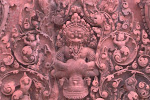Thursday, 02 July 2009
Stephanie Mee
The Phnom Penh Post
AN old English proverb says, "Good wine needs no bush", meaning that something of good quality does not need to be advertised. This is especially true of Cambodia's traditional alcoholic beverage srah sohl, or rice wine.
As rice is the primary staple of most Cambodian diets, it comes as no surprise that the cheapest and most popular alcoholic beverage for most Cambodians is a potent brew made from the plentiful grain.
Similar to sake from Japan or cheongju from Korea, rice wine in Cambodia is produced by fermenting grains of rice until the starches in the rice convert into sugars, resulting in a mildly alcoholic liquid. Unlike wine made from grapes, the fermentation period can take as little as 24 hours.
"Once you have the equipment, the process is quite simply really," said Dos Lun of Tang Russey village in Takeo province.

Every second day Dos Lun boils 25 kilos of rice, lays it to dry in the sun, and then transfers it to plastic buckets, where it is mixed with a natural fermenting agent called dom bai in Khmer. The mixture is then left to bubble and ferment overnight. Once the rice has fermented, it is dumped into a large metal vat along with pure rainwater and covered with a purpose-built lid, sealed with a rice husk paste.
Leftover rice husks and scrap wood are used to start a small fire under the vat, heating the rice mixture so that the watery, alcoholic mixture evaporates, travelling up two metal pipes protruding from the lid and down through a concrete container full of water. The water in the container cools the liquid in the pipes, and a small spigot at the bottom of the container releases the clear, pure, mildly grainy-flavoured rice wine.
"There are three stages of wine," said Dos Lun. "The first batch is extremely strong, and is not suitable for drinking. The second stage is the best, at about 30-percent alcohol content, and the third stage is very weak. I often mix the first and third batches to create an evenly balanced blend."
Dos Lun sells his natural rice wine from his stilted wooden house in the midst of rice fields and cow paddocks for 2,000 riels a litre, and can sell as many as 20 litres a day. "People like to buy rice wine from me because they know it's natural and not bad for you," he said. "You have to be careful because some producers of rice wine that sell in bulk from stores or roadside stalls put chemicals and pesticides in the wine to make it taste stronger, but really it just makes you sick."
Takeo native Khem Sokkhieng said, "I like to drink rice wine during special festivals or holidays and sometimes when I'm relaxing with friends or family, but some people drink it every day. Farmers who work in the rice fields will often drink one glass of srah sohl in the morning before they go to the fields in order to warm their body, and then again at night to relax."
Srah sohl can also be used as a base for traditional Khmer medicinal remedies, which many claim can cure everything from muscle aches, fatigue and stomach disorders to menstrual cramps and labour pains.
Medicinal rice wine in Cambodia goes by the name srah tinum, and can be produced by infusing pure rice wine with items such as herbs, roots, tree bark, and even insects.
Chen Veasna, owner of Restaurant No 66, a family-run restaurant on Street 360, has been selling srah tinum at the two-level restaurant for fifteen years, and believes wholeheartedly in its healing powers.
"All of the wine we sell here is good for aches and pains in the body," she said. "Some of the varieties are particularly good for women, although anybody can drink any of the varieties. And the greatest advantage of our wine is that it doesn't burn your stomach when you drink it because it contains no harsh mixtures or harmful ingredients."
Varieties of medicinal rice wine at the restaurant include srah gondia, a dark, rum-coloured brew that is made by infusing red termites in rice wine and then straining the bodies out. The resulting drink tastes a bit sweet and earthy, with flavours of almonds and nutmeg. It is said to help with blood circulation and menstrual cramps.
Srah bondul pich is made from the woody stems of a small plant native to Cambodia and possesses a vibrant yellow colour, with an extremely strong, bitter taste that coats the tongue long after it is swallowed. It is said to be most beneficial for elderly people and cure arthritis, rheumatism and body pains.
Srah tinum chen sei is the most common type of medicinal rice wine in Cambodia and is often taken to alleviate stomach disorders and fatigue. The best tasting wine by far at Restaurant No 66 is srah dom narp k'mull, a strongly alcoholic, sweet and slightly spicy blend, made from black sticky rice. The busy restaurant also sells regular srah sohl.
All rice wine at Restaurant No 66 is sold by the litre and varies in price depending on the variety. "I can't even count the number of people that come here every day to purchase rice wine," said Chen Veasna. "People love it because it is healthy and it won't give you a headache or hangover the next morning, provided, of course, you don't go overboard on it."
Whether imbibed as a social lubricant, for pleasure, or for curative purposes, srah sohl is a long-established element of traditional Khmer culture, and to quote a common Khmer colloquialism, "If you don't drink, how will the rice wine merchant make his living?"


No comments:
Post a Comment